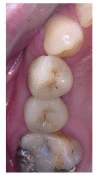Long-Term Effects of Acute Myeloid Leukemia Treatment on the Oral System in a Pediatric Patient
- PMID: 29760815
- PMCID: PMC5897961
- DOI: 10.2174/1874210601812010230
Long-Term Effects of Acute Myeloid Leukemia Treatment on the Oral System in a Pediatric Patient
Abstract
Introduction: Acute Myeloid Leukemia (AML) in pediatric patients is a serious disease, although, for the subgroup of patients who receive proper treatment, a long-term survival rate above 50% is typical. The cycles of chemo- and radiotherapy used to treat AML can impair dental development.
Case report: Herein, we describe the oral condition of a 25-year-old male patient treated for AML with chemo- and radiotherapy from 5 to 7 years of age; his AML has remained in remission for the past 18 years. He had lost only one permanent tooth, but the remaining teeth demonstrated serious deformations and radicular hypoplasia. Two teeth required immediate extraction and subsequent replacement by implant-supported crowns. We found that the decayed, missing, filled teeth (DMFT) index was not representative of the real oral condition. Here, we report the full case and provide a brief review of the literature.
Conclusion: Antitumor treatment of pediatric leukemia can induce total impairment of dental development and function. These adverse effects may become clinically evident many years after the resolution of cancer, and can be significantly detrimental to the patient's quality of life.
Keywords: Acute myeloid leukemia; Bone marrow transplantation; Children teeth; Dental anomalies; Dental implants; Long-term effects.
Figures
References
-
- Zwaan C.M., van den Heuvel-Eibrink M.M. Pediatric Acute Myeloid Leukemia. In: Antica M., editor. Acute Leukemia - The scientist’s perspective and challenge. Ed, Antica M. InTech. Vol. 10. 2011. pp. 235–76.
-
- Doumbia M., Uwingabiye J., Bissan A., Rachid R., Benkirane S., Masrar A. Epidemiological, clinical, cytologic and immunophenotypic aspects of acute leukemia in children: The experience at the hematology laboratory of IBN SINA University Hospital Center. Pan Afr. Med. J. 2016;23:258. doi: 10.11604/pamj.2016.23.258.8396. - DOI - PMC - PubMed
-
- Linabery AM, Ross JA. Trends in childhood cancer incidence in the U.S. (1992-2004). Cancer. 2008 ; 15; 112(2):416–432. - PubMed
-
- Sonis AL, Tarbell N, Valachovic RW, et al. Dentofacial development in long-term survivors of acute lymphoblastic leukemia: A comparison of three treatment modalities. Cancer. 1990 ; 15; 66(12):2645–2652. - PubMed
Publication types
LinkOut - more resources
Full Text Sources
Other Literature Sources
Miscellaneous






